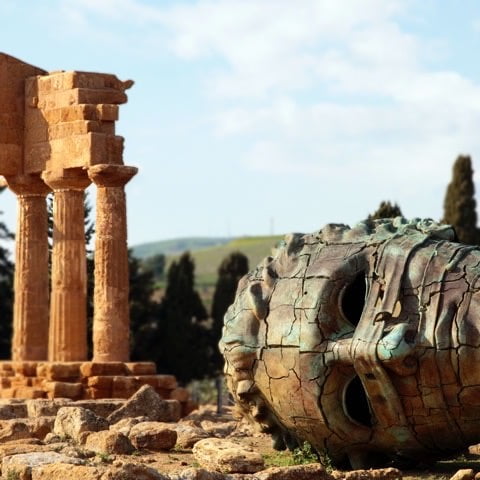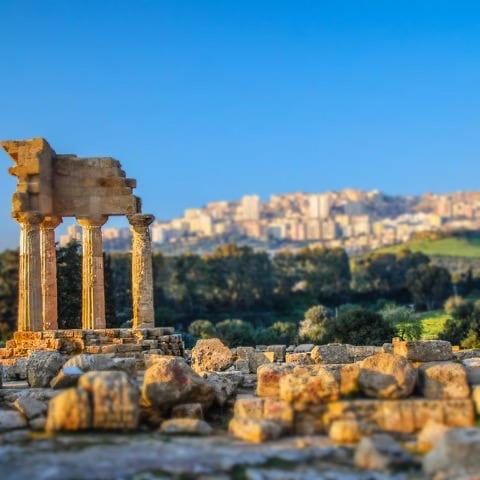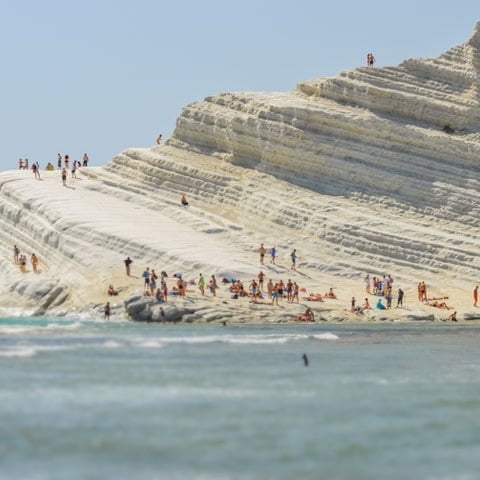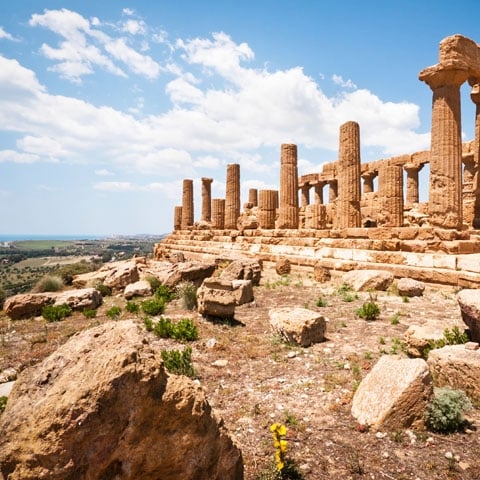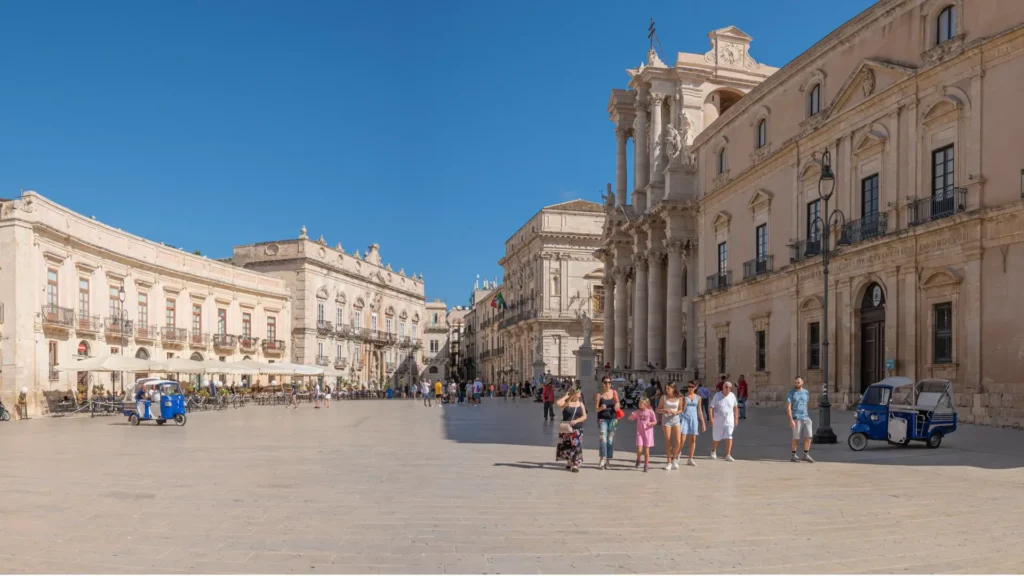Nestled into the middle of the Mediterranean Sea at the southern edge of the Italian island of Sicily, is the city of Agrigento. This beautiful city which is a blend of ancient and modern time periods is the capital of the province of its namesake. Whether you are a history buff or are simply drawn to the ancient beauty of this Italian jewel with deep Greek roots, Agrigento is a wonderful and unique experience for travelers touring the magnificent country of Italy.
Just miles from the Mediterranean coast, the city of Agrigento is one of the top historical sites in Sicily. The ancient part of this town, the Valley of Temples, which sits on a nearby rocky ridge is considered to be one of the top historical sites in Sicily and in Italy. Many of the original temple sites are mostly ruins today, but more than a dozen of these limestone temples once populated the ridge and were a huge part of the residents’ daily lives.
It is estimated that Agrigento, then named Akragas, was the third largest city in the Greek world in 5 BC. The city was originally founded by people who left Greece to colonize surrounding areas. As a result, much of Italy’s coastal areas were populated by Greek settlers, leading to the name Magna Graecia. One of the defining characteristics of the city at the time was the almost seven-mile-long wall carved out of the existing rocks of the ridge. Eventually the Romans overtook the ancient area, but it still retained much of the original Greek influence.
Although most of the travelers who come to Agrigento simply pass through the modern-day city to get to the Valley of Temples, it is thriving. At the heart of the city visitors can take delight in historic churches, piazze, shops, and charming cafés that line the winding roads. While the historical center of the town is a reminder of ancient times, the surrounding parts of the city limits are urban, with tall and modern buildings creating the skyline.
When traveling to the Italian island of Sicily, most visitors arrive via airplane or a boat from the mainland. Those navigating the sites of Agrigento can usually do so by car. The exception to this rule is the Valley of Temples, where it requires an automobile ride to the main area after which visitors generally do better to explore on foot.
The cuisine of Agrigento, like the rest of the island of Sicily, is marked by Arab influences. The proximity of the city’s location to the Mediterranean Sea makes seafood a popular menu item along with some of the local favorites of olives, sundried tomatoes, artichokes, and salted anchovies. As in most Italian cities, pasta is a staple here along with some outstanding desserts courtesy of local pastry shops. Regardless of what delicacies you dine on, a meal in Agrigento is best enjoyed with family, friends, and a fine bottle of Italian wine.
GEOGRAPHY
The city of Agrigento is located in a province of its namesake within the Italian region and island of Sicily. It is considered to be both a modern and ancient town. The modern part of Agrigento sits atop a hill and overlooks the ancient part of the city which sits on a nearby rocky ridge.
The modern part of the city is quite urban in appearance, but the further one goes from the city limits the more rural the landscape becomes. The surrounding areas of the city are green and, in some places, can even offer a picturesque view of the Mediterranean Sea.
CLIMATE
The city of Agrigento enjoys mostly comfortable temperatures throughout the year, making a visit at almost any time of year a great experience.
The summer months tend to see the highest number of travelers primarily because of the warm temperatures which generally peak in the low eighties (degrees Fahrenheit) and bottom out in the high fifties. The rainfall rates for summer are on average fairly low.
The fall brings temperatures that decrease steadily from the summer resulting in an average high of the fifties by November, with a low in the forties. Winter continues that downward temperature trend with an average high in the forties and lows above freezing.
The fall and winter months also tend to experience more rainfall than the other seasons.
Spring brings a gradual warm up with temperatures reaching almost seventy degrees by May, with lows around the fifties. Rainfall amounts are a little higher in March and slowly taper off as summer approaches.
ONLY IN AGRIGENTO
When visiting Agrigento, travelers are almost universally drawn to the Valley of Temples in the ancient part of the city once known as Akragas. The area is roughly eight square miles and is the site where approximately a dozen or so temples once stood, earning it the title of United Nations Educational Scientific Cultural Organization (UNESCO) World Heritage Site. This historical area is one of the best examples of Greek ruins in the world.
Of all the Greek temples that once majestically towered over ancient Akragas, the only one that is largely still intact is the Temple of Concordia. The structure is estimated to have been built in 430 BC and is probably still standing today because its structure was reinforced over the years and because it was used as a Christian basilica for a time. This limestone temple faces the east as most Greek temples did, and the perimeter is comprised of a stairway and at least two dozen stately columns.
The Temple of Olympian Zeus once stood here in this same area and was enormous at an estimated three hundred feet long. Although the temple is strictly in ruins today, historians and archaeologists believe the temple once had one of the largest altars in the area for animal sacrifices.
Other temples located here include the Temple of Juno (Tempio di Giunone), Temple of Hercules (Tempio di Ercole), the Temple of Castor and Pollux (Tempio di Castore e Polluce), and the Temple of Hephaestus (Tempio di Vulcano). Many of these structures are largely ruins today thanks to the weathering effects of time and an earthquake that occurred hundreds of years ago.
Travelers hoping to explore the Valley of Temples should plan to take transportation to the actual site before continuing on foot. This historical area is vast and spread-out requiring visitors to travel some decent distances by foot from temple to temple. The Valley of the Temples in ancient Agrigento is a one-of-a-kind experience that typically takes several hours to explore and enjoy.
Best known for the historic Valley of the Temples, the city of Agrigento is an excellent place to experience Sicily’s ancient Greek past. History lovers will rejoice at the sight of the temples, which are considered to be the best surviving examples of ancient Greek architecture outside of Greece.
